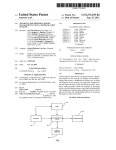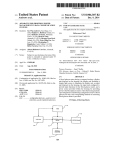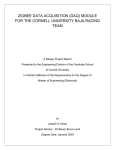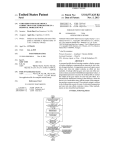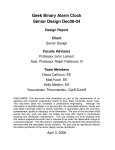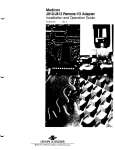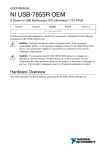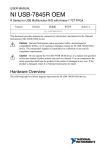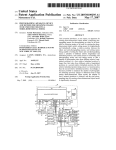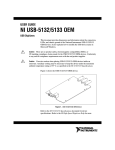Download Method and Apparatus for Providing Power Management in Data
Transcript
US 20100137698A1 (19) United States (12) Patent Application Publication (10) Pub. No.: US 2010/0137698 A1 Andrews et al. Jun. 3, 2010 (43) Pub. Date: (54) METHOD AND APPARATUS FOR (22) Filed: Nov. 24, 2009 PROVIDING POWER MANAGEMENT IN _ _ Related U-S. APPllCatlOIl Data (63) (75) Inventors: Tae Wan Andrews, San Diego, CA (US); Stephen C. Bubrick, Orinda, Continuation of application No. 10/861,626, ?led on Jun. 4, 2004. - - CA (Us); sheilah s‘ Estoesta, - Mountain View, CA (US); Brad D. ’ Etter, Fremont, CA (US); Hyoung Yoon Park, Duluth, GA (US); ' Publication Classi?cation Gene Ming Pon, San Jose, CA (51) 1141221515145 2006 01 (US); ChristopherV. Reggiardo, ( Castro Valley’ CA (Us); Heber (52) Saravia, Daly City, CA (US) (57) Correspondence Address: JACKSON & CO_ LLP 6114 LA SALLE A’VENUE #507 ' ) US. Cl. ...................................................... .. 600/365 ABSTRACT A blood glucose meter having a compact housing, a display unit disposed on the housing, the display unit including a display light source to illuminate the display unit, an input unit disposed on the housing, the input unit con?gured to OAKLAND CA 94611_28(;2 (Us) ’ _ - (60) ll’goélszgnal application No. 60/478,436, ?led on Jun. provide input functions for the blood glucose meter, and a _ poWer source provided Within the housing for providing (73) Asslgnee: Abbott Dlabetes Care Inc" Alameda’ CA (Us) poWer to the blood glucose meter, Where the housing includes a port integrated on said housing con?gured to receive a blood (21) Appl. No.: 12/625,502 glucose test strip, and corresponding methods of measuring blood glucose meter is provided. 101 *P USER 1 04 TEST snap 102 E GLUCOSE METER uEvlcE 103 / EXTERNAL COMPUTER 105/ <_~> LANCING DEVICE. Patent Application Publication Jun. 3, 2010 Sheet 1 0f 6 US 2010/0137698 A1 0.2M6US5O F\ or KmwD MWEOFDJU NUSO ‘I! hQwEkW 2. \Ino? mvMDQE Patent Application Publication Jun. 3, 2010 Sheet 3 0f 6 US 2010/0137698 A1 301 307 302 303 305 \ @ ® 304 / 306 309 308 310 FIGURE 3 Patent Application Publication Jun. 3, 2010 Sheet 4 of6 US 2010/0137698 A1 41 413 F4IGUBRE 104 414 4089 404 405 302 403 401 402 F4IGUARE Patent Application Publication Jun. 3, 2010 Sheet 5 0f 6 501 US 2010/0137698 A1 DETECT TEST STRIP INSERTION I VERIFY IN SERTED TEST STRIP AND PERFORM SELF TEST I 5°3 A TURN on DISPLAY mo PROMPT USER To ENTER OR com-1m TEST STRIP CALIBRATION CODE 504 .1 PROMPT USER TO APPLY BLOOD SAMPLE TO TEST STRIP 505 SAMPLE DETECTION COMPLETE? YES 50s 7 /\ SIGNAL TO USER THAT SAMPLE FILL ls COMPLETE AND GLUCOSE LEVEL IS NOW BEING ANALYZED I 507 DETERMINE GLUCOSE VALUE CORRESPONDING TO DETECTED BLOOD SAMPLE 50a 1 -—-_\ DISPLAY DETERMINED GLUCOSE VALUE AND STORE IN M EMORY FIGURE 5 Patent Application Publication Jun. 3, 2010 Sheet 6 0f 6 US 2010/0137698 A1 A$x2vo:m @QMDUE éP/$0< Jun. 3, 2010 US 2010/0137698 A1 METHOD AND APPARATUS FOR PROVIDING POWER MANAGEMENT IN DATA COMMUNICATION SYSTEMS tained at the on position. Indeed, in one embodiment, the RELATED APPLICATIONS adjusting the duty cycle and the period during Which the light central processing unit of the glucose meter device may be con?gured to control the sWitching on and off of the light source as Well as the level of light intensity by, for example, source is con?gured to be turned on. [0001] This application is a continuation application of pending US. patent application Ser. No. 10/861,626 ?led Jun. 4, 2004, Which claims priority under 35 USC §ll9 to Provisional Application No. 60/478,436 ?led Jun. 12, 2003, entitled “Method and Apparatus for Providing PoWer Man agement in Data Communication Systems”, the disclosures of each of Which are incorporated herein by reference for all [0007] Additionally, in accordance With a further aspect of the invention, the blood glucose meter may include a numeri cally displayed clock With a date display Which may be visible When the meter is not in use. Moreover, the clock feature in yet a further embodiment of the present invention may purposes. reminder for performing blood glucose level testing, Where include an alarm Which Would alloW the users to set alarm the alarm feature may include one or a combination of an BACKGROUND [0002] The present invention relates to data monitoring systems. More speci?cally, the present invention relates to portable analyte monitoring systems. More speci?cally, the present invention relates to a compact, blood glucose meter for use in a glucose monitoring system to self-monitor glu auditory alarm, a visual alarm alert, and a vibration alert mode. [0008] Indeed, a blood glucose meter in accordance With one embodiment of the present invention includes a compact housing for a blood glucose meter, a display unit disposed on the housing, the display unit con?gured to display informa cose level in Whole blood, as an aid to disease management, tion related to the blood glucose meter, an input unit disposed and also by healthcare professionals as an aid to monitor the effectiveness of diabetes treatment. functions for the blood glucose meter, and a poWer source SUMMARY OF THE INVENTION [0003] The market for glucose monitoring systems in the United States as Well as globally is rapidly increasing, as better health education and early detection of diabetic condi tions through regular check ups have increased the percentage of the diabetic population Who undertake the task of moni toring their diet and daily activities based on the detected level of blood glucose using glucose monitoring systems. One group of such rapidly increasing segment of the population is on the housing, the input unit con?gured to provide input provided Within the housing for providing poWer to the blood glucose meter. [0009] The display unit may include one of a liquid crystal display (LCD), a touch sensitive screen, and a plasma display unit. [0010] The display unit may also include a light source to illuminate the display unit, Where the light source may be con?gured to provide a backlight function and a ?ashlight function of the display unit. [0011] The light source in one embodiment may be con?g their blood glucose levels. ured to be pulsed at a frequency greater than 60-100 Hertz. Moreover, the light source may further con?gured to have a [0004] peak Wavelength of approximately 570 nanometers. children With diabetic conditions Who are advised to monitor While miniaturization has been a factor of recent designs in the glucose monitoring systems and the glucose [0012] meters, the physical constraints of the components of such light emitting diode (LED), and more speci?cally, a yelloW systems have established a certain siZe limitation. As such, the larger and bulkier the device, the less desirable and con green LED. [0013] In a further embodiment, the housing may include a venient for the device to be carried around or used and oper ated by the patients, especially children. [0005] In vieW of the foregoing, in accordance With the various embodiments of the present invention, there is pro vided a blood glucose meter Which is designed to be substan tially more compact than presently available commercial blood glucose meters, Which con?guration that is much more amenable to usage and portage by younger diabetic patients such as children. [0006] More speci?cally, in one aspect of the invention, the blood glucose meter is con?gured to include a LCD backlight and a ?ashlight features Which Will assist the patient in read ing the metered glucose level in loW-light testing areas such as in theaters, loW ambient light restaurants, areas, outdoors during non-daylight times and so on, as Well as a light source to guide the insertion and removal of the test strip, Which may include the usage of a light emitting diode. Indeed, as the light source (e.g., the LED) may be pulsed and still display sub stantially the same light output as one Which is turned on in steady state, the battery life of the glucose meter device may be prolonged since the pulsed LED light source requires signi?cantly less poWer (and thus draining the battery at a much sloWer rate) than When the LED light source is main In one embodiment, the light source may include a port integrated on the housing con?gured to receive a blood glucose test strip. [0014] The port may include a light source that may be con?gured to substantially illuminate the port to assist in the insertion and/ or removal of the blood glucose test strip. [0015] In yet another embodiment, the display unit may be con?gured to illuminate upon detection of a blood glucose test strip insertion into the port. Further, the display unit may be con?gured to remain illuminated until the test strip is removed from the port. [0016] The input unit in one embodiment may include an on/off sWitch. [0017] A blood glucose meter in accordance With another embodiment includes a compact housing for a blood glucose meter, a display unit disposed on the housing, the display unit including a display light source to illuminate the display unit, an input unit disposed on the housing, the input unit con?g ured to provide input functions for the blood glucose meter, and a poWer source provided Within the housing for providing poWer to the blood glucose meter, Where the housing includes a port integrated on said housing con?gured to receive a blood glucose test strip. Jun. 3, 2010 US 2010/0137698 A1 [0018] The port in one embodiment may include a port light source, the port light source con?gured to substantially illu minate the port to assist in the insertion and/or removal of the blood glucose test strip. [0019] Additionally, in an alternate embodiment, the port light source may be integrated With the display light source. [0020] A method of measuring blood glucose level in accordance With yet another embodiment of the present invention includes the steps of providing a compact housing, disposing a display unit on the housing, the display unit including a display light source to illuminate the display unit, disposing an input unit on the housing, the input unit con?g ured to provide input functions for the blood glucose meter, providing a poWer source Within the housing for providing poWer to the blood glucose meter, Where the housing includes from the user 101 to be collected onto the test strip 102. In one embodiment, the lancing device 104 may be used on the user’s ?ngers, forearm, upper arm, hand, thigh or calf, for example. Moreover, the glucose meter device 103 and the system 100 is con?gured such that a very small blood sample siZe such as, for example, approximately 0.3 microliter of sample blood, is necessary to determine a corresponding blood glucose level. [0030] As can be further seen from FIG. 1, the glucose meter device 103 may be operatively coupled to an external computer 105 Which may include, in one embodiment, a server terminal connected to a data netWork, a stand along desktop or laptop computer for use by the user’s physician or care provider (or the user herself), a personal digital assistant (PDA) Which is operatively con?gured to store and/or further, a port integrated on said housing con?gured to receive a blood to communicate With a data netWork to transmit and receive glucose test strip. patient data related to the glucose level detected from the [0021] These and other features and advantages of the present invention Will be understood upon consideration of the folloWing detailed description of the invention and the collected blood sample, for further diagnosis, analysis and the [0022] Applicants herein incorporate by reference U. S. Pat. like. [0031] In one embodiment, the user 101 may provide the con?guration parameters as Well as calibration code to the glucose meter device 103, While the glucose meter device 103 may be con?gured to output signal prompts to the user 101 such as to indicate a sample ?ll signal and a sample result No. 6,616,819 issued Sep. 9, 2003 entitled “Small Volume In Vitro Analyte Sensor and Methods”, US. Pat. No. 6,560,471 issued on May 6, 2003 entitled “Analyte Monitoring Device and Methods of Use”, and US. Provisional Application No. blood glucose level from the sampled blood from the user 1 01. Furthermore, after the user 101 is lanced With the lancing device 104 to generate suf?cient amount of sample blood, the accompanying draWings. INCORPORATION BY REFERENCE 60/437,374 ?led Dec. 31, 2002 and US. Published Applica tion No. 2004/0186365 published Sep. 23, 2004 both entitled “Continuous Glucose Monitoring System and Methods of Use”, each assigned to theAssignee of the present application for all purposes. BRIEF DESCRIPTION OF THE DRAWINGS [0023] FIG. 1 is a block diagram illustrating an overall glucose monitoring system in accordance With one embodi ment of the present invention; [0024] FIG. 2 is a block diagram illustrating a glucose meter device shoWn in FIG. 1 in accordance With one embodi ment of the present invention; [0025] FIG. 3 illustrates the glucose meter device of FIG. 2 in accordance With one embodiment of the present invention; [0026] FIGS. 4A and 4B illustrate the display screen of the glucose meter device in accordance With one embodiment of the present invention; [0027] FIG. 5 is a ?owchart illustrating the procedure for performing a blood glucose test using the glucose meter device in accordance With one embodiment of the present invention; and [0028] FIG. 6 illustrates the output LED poWer level as a function of the poWer state in accordance With one embodi ment of the present invention. DETAILED DESCRIPTION [0029] FIG. 1 is a block diagram illustrating an overall glucose monitoring system in accordance With one embodi ment of the present invention. Referring to the Figure, the glucose monitoring system 100 in accordance With one embodiment includes a glucose meter device 103 con?gured signal, and further, to output display the resulting measured test strip 102 is provided in contact thereto (i.e., to the sample blood) While the test strip 102 is operatively coupled to the glucose meter device 103. In this manner, the glucose meter device 103 may in one embodiment be con?gured to alert the user that the amount of blood sample on the test strip 102 is suf?cient to determine the corresponding blood glucose level. [0032] In one aspect of the present invention, the glucose meter device 103 may be con?gured to make clinical mea surements of glucose in Whole blood in the range for approxi mately 20 to 500 mg/dL. Furthermore, as discussed in further detail beloW, the glucose meter device 103 may be con?gured to include a display unit Which is con?gured to operate as a user interface to visually interact With the user 101 to prompt for data input, or alternatively, to provide information to the user 101 corresponding to the user’s operation of one or more functions of the glucose meter device 103. In one embodi ment, the display unit of the glucose meter device 103 may include a LCD display screen Which may further be con?g ured, in an alternate embodiment to include a touch-sensitive pad so as to alloW the user 101 to input data therethrough. Moreover, in a further embodiment of the present invention, the display unit of the glucose meter device 103 may be con?gured to include a backlight feature Which Would permit the user 101 to operate the glucose meter device 103 in a dark ambient setting such as in a theater, outdoor at night, and the like. [0033] FIG. 2 is a block diagram illustrating a glucose meter device shoWn in FIG. 1 in accordance With one embodi ment of the present invention. Referring to FIG. 2, the glucose meter device 103 in accordance With one embodiment of the present invention includes a central processing unit 206 operatively coupled to a digital data processing unit 204. The central processing unit 206 is further operatively coupled to a to receive a test strip 102 Which is used to collect the blood storage unit 207 Which, in one embodiment, may include one sample for determining the blood glucose level of the user 101. The lancing device 104 is used to draW the blood sample or more of a data storage unit, a random access memory unit and a read-only memory unit. As can be further seen from the Jun. 3, 2010 US 2010/0137698 A1 Figure, the digital data processing unit 204 is further opera tively coupled to an input/ output (I/O) interface unit 205 to generate and output an audible sound for each speci?c Which, in one embodiment, is con?gured to interface With the into the glucose meter device 103. Moreover, in a further embodiment, the audible alarm output (or a series of audible tones as may be selected by the user) may be simultaneously external computer 105 (FIG. 1). [0034] Moreover, in the glucose meter device 103, there is provided an analog data processing unit 201 Which is con?g ured to detect and process analog signals and Which is further operatively coupled to the digital data processing unit 204 for digital data processing of the detected and processed analog signals received from the analog data processing unit 201 in event or reminder Which the user 101 has pre-programmed generated With the backlight feature of the glucose meter device 103 such that for each of use, the user is able to vieW information displayed on the display unit of the user interface one embodiment of the present invention. Referring back to unit 203 substantially immediately Without the need to per form extra steps such as turning on the backlight function of the glucose meter device 103. In the preferred embodiment, FIG. 2, the analog data processing unit 201 of the glucose meter device 103 is further con?gured to operatively couple the meter alloWs the user to set up to four separate alarms to go off every 24 hours at a particular time to remind the user to to a test strip connector unit 202 Which is con?gured to test her blood glucose level. Preferably, the volume of each alarm may be set independently. [0038] Referring back yet again to FIG. 2, in one embodi ment of the present invention, the central processing unit 206 is con?gured to perform a plurality of functions to maintain, calibrate and operate the glucose meter device 103. More speci?cally, upon poWer up of the glucose meter device 103 engage With a test strip 102 (FIG. 1) When inserted into the glucose meter device 103. Thereafter, the analog data pro cessing unit 201 as mentioned above is con?gured to detect the signal level from the collected blood sample received from the test strip 102 (FIG. 1) via the test strip connector unit 202, and to transmit that detected and analog processed data to the digital data processing unit 204 for further data pro cessing. When the poWer source such as the batteries, are placed in the Referring yet again to FIG. 2, there is also shoWn a respective section of the device housing, under the control of the central processing unit 206, the glucose meter device 103 user interface unit 203 provided to the glucose meter device 103. As can be seen, the user interface unit 203 is operatively coupled to the user 101 (FIG. 1) to receive input data or instructions therefrom, or alternatively, to output the pro cessed and/or generated information to the user 101. More speci?cally, in accordance With one embodiment of the present invention, the user interface unit 203 may include a display unit, an input device such as an input keypad, or any iZe the various aforementioned components of the glucose meter device 103 to the necessary con?guration settings. Upon successful completion of the poWer on/reset sequence, the central processing unit 206 is then con?gured to enter the glucose meter device 103 into a default operation mode (for example, the clock mode) as discussed in further detail beloW. More speci?cally, in one embodiment, the central processing other equivalent device Which may provide substantially the unit 206 is con?gured to access the storage unit 207 to retrieve the corresponding poWer on/reset sequence instruction set [0035] same functionality as the input device such as an input key pad. [0036] Additionally, the display unit of the user interface unit 203 may include an LCD display unit Which is also capable of providing backlighting so as to permit the user to vieW the displayed information on the backlit display unit of the user interface unit 203 in dark ambient settings. Moreover, in an alternate embodiment of the present invention, the user interface unit 203 may also include a ?ashlight feature Which, upon activation by the user, is con?gured to emit a consistent light beam to assist the user in the operation of the glucose meter device 103 and/or the lancing device 104 in dark sur roundings. Further, the ?ashlight feature may also be con?g ured to include a timer function such that the ?ashlight is con?gured, in one embodiment, to automatically turn off is con?gured to perform a poWer on/reset sequence to initial from the storage unit 207 (for example, in the ROM portion and/or the RAM portion thereof). Moreover, in one embodi ment, the central processing unit 206 is con?gured to perform and complete the aforementioned poWer on/reset sequence Within approximately 500 mseconds. [0039] In one aspect, the central processing unit 206 of the glucose meter device 103 may be con?gured for operating the meter device 103 in one of the folloWing modes of opera tionithe clock mode (the default mode discussed above), the test mode, the con?guration mode, and the measurement log revieW mode. The default clock mode is con?gured in one embodiment to display the time/ date information as con?g ured by the user 101. The test mode includes operations for the user to perform blood glucose measurements, the con?gu after a predetermined period of time has elapsed. In this ration mode includes functions for the user to select user manner, the poWer source for the glucose meter device 103 (FIG. 1) may be conserved in the cases Where the user 101 leaves the ?ashlight feature on the glucose meter device 103 preferences for con?gurable parameters of the glucose meter device 103, and the measurement log revieW mode alloWs revieWing of the glucose measurements stored in the meter audio signals. More speci?cally, in one aspect of the present device 103. [0040] In one embodiment, When the glucose meter device 103 enters a non-clock mode of operation, the meter device 103 may be con?gured to display a self-test screen that illu minates all segments of the display unit in the user interface invention, the user 101 may be alerted or reminded of one or more time speci?c events or reminder such as the next time the user 101 needs to take a blood glucose level measurement. unit 203 prior to operating in the selected mode of operation. Moreover, the glucose meter device 103 may be con?gured to exit all operation modes after exceeding a predetermined Rather than relying solely upon the user’s memory, the glu period of non-activity/idle time (for example, 2 minutes) such on. [0037] Referring yet again to FIG. 2, the user interface unit 203 in accordance With a further embodiment of the present invention may include a speaker unit con?gured to output cose meter device 103 may be con?gured With an alarm as no sWitch activity, test strip activity, or display activity, for feature operatively engaged With a timer function such that, in example. addition to displaying the current time information on the [0041] Additionally, the central processing unit 206 of the glucose meter device 103 is con?gured such that, upon detec display unit, the glucose meter device 103 may be con?gured Jun. 3, 2010 US 2010/0137698 A1 tion that there Was a loss of power (for example, battery removal), the internal date is set to the last recorded date, and in the case Where there is no valid recorded dates, the central processing unit 206 is con?gured to set the internal date to a predetermined date such as Jan. 1, 2002, for example. Like Wise, upon detection of the loss of poWer, the internal time in one embodiment is reset to 12 :00 am until a further time When the user resets the internal time. Moreover, the blood sample test data collected during the period of poWer loss is con?g ured to be ?agged With a “lost time” ?ag and the correspond ing lost poWer internal date and time discussed above. Upon re-application of poWer to the glucose meter device 103, in one embodiment, the user may be prompted (e.g., blinking signals displayed on the user interface unit 203) to reset the time and date information in the default clock mode. [0042] Referring still again to FIG. 2, in the test mode of operation of the glucose meter device 103 in one embodi ment, the correct insertion of the test strip 102 (FIG. 1) engaged into the test strip connector unit 202 of the meter device 103 is detected, and upon removal of the test strip 102, the meter device 103 is con?gured to enter the default opera tion mode. In this manner, the glucose meter device 103 may be con?gured to automatically enter into the test mode of operation upon the correct insertion of the test strip 102. Alternatively, the glucose meter device 103 may be con?g urable to enable manual initiation of the test mode of opera tion (such as, for example, by the user’s manual operation of the test mode sWitch (not shoWn) of the meter device 103. [0046] In the measurement log revieW mode of operation discussed above, the glucose meter device 103 is con?gured to display a glucose summary (that is, the average glucose level information) of stored results, as Well as other param eters such as the number of measurements incorporated into the displayed average level, and a visual indication to the user that the displayed data is the average glucose level informa tion, and not a speci?c sampled glucose level data. As Will be discussed in further detail beloW, the glucose meter device 103 may be con?gured to enter the measurement log revieW mode of operation upon the operation of the mode sWitch (in the user interface unit 203) While the meter device 103 is in the default clock mode. [0047] In one embodiment, the glucose meter device 103 may be con?gured so that a “L0” is displayed for measured glucose values Which are beloW 20 mg/dL, and in contrast, a “HI” is displayed When the measured glucose value exceeds 500 mg/dL. Furthermore, the meter device 103 may be con ?gured to display the processed glucose level Within approxi mately 15 seconds from the sampling of the corresponding blood for samples beloW 200 mg/dL When measured at room temperature and humidity. [0048] FIG. 3 illustrates the glucose meter device of FIG. 2 in accordance With one embodiment of the present invention. As shoWn, the glucose meter device 103 includes a housing 307 Which substantially encases the meter device 103. In one embodiment, the glucose meter device 103 may be physically con?gured such that it is 3.12 inches in length, 2.25 inches in Width and 0.85 inches in height, With no more that 1 .4 ounces [0043] During the test mode of operation, if a faulty opera tion is detected, the glucose meter device 103 is con?gured to generate and output a corresponding respective message as used for the housing 307 may comprise plastic, metal, poly such. Examples of such faulty operation includes, but not mer, or a combination of any suitable material Which provides limited to, the detection of a used test strip, insu?icient blood sample on the test strip, incorrect insertion of the test strip into the test strip connector unit 202 of the meter device 103, or When the coulometer circuits are not ready for sample pro cessing. The outputted message to the user alerting of the faulty operation may include an audible sound, a visual dis substantial physical integrity When subject to normal usage of the meter device 103 including occasional dropping and other in Weight With the batteries installed. Moreover, the material physical impacts. [0049] Also shoWn in FIG. 3 is a data port 301 Which corresponds to the I/O interface unit 205 (FIG. 2), and is [0044] Upon successfully collecting su?icient blood con?gured to operatively couple to an external computer or data processing device to transfer data collected and pro cessed by the glucose meter device 103. The data port 301 in sample for processing from the user 101 (FIG. 1), the glucose one embodiment may include one of a Universal Serial Bus play, or a combination of both. meter device 103 is con?gured to process the collected (U SB) port, an infrared data communicationport, a Bluetooth sample, and to generate a corresponding blood glucose data communication port, and a Wi-Fi Wireless data communica for output display to the user 101 on the user interface unit tion port (for example, IEEE 802.11 or its equivalents). [0050] Referring back to FIG. 3, provided on the housing 203. The blood glucose data may be, for example, displayed in units of mg/dL or in units of mmol. Moreover, in one embodiment, the meter device 103 may also be con?gured to 307 is a display screen 302 Which may be con?gured to display the test results and other parameters and information such as time and data information and the like. The display display the time and date information corresponding to the blood glucose level test. Moreover, the central processing unit 206 is further con?gured to store the processed and displayed blood glucose data in the storage unit 207. [0045] Referring still to FIG. 2, in the con?guration mode of operation, in one embodiment of the present invention, the ured to automatically sWitch on in loW-light settings for a user 101 may select and input certain predetermined param eters into the glucose meter device 103 to con?gure the meter device 103 for subsequent use thereafter. For example, such mode sWitch 303, the con?guration sWitch 304, and the light con?gurable parameters include the displayed date and time operated by the user to toggle betWeen different operation information, the alarm settings on the glucose meter device 103, the preferred display format for data display on the modes such as the test mode, and the clock mode (default), display unit of the user interface unit 203 in the meter device each discussed above. The con?guration sWitch 304 may be con?gured to, for example, mark a test result as control solu 1 03, the concentration unit of the generated glucose level, and an average glucose level information based on a user selected number of days such as 14-day or 30 day average of stored results. screen 302 in one embodiment may include a built-in display backlight for use in loW-light conditions, and may be con?g predetermined period of time (such as 1 minute, for example), or may be con?gured for manual user operation. [0051] Also shoWn in FIG. 3 are three input sWitchesia sWitch 305. In one embodiment, the mode sWitch 303 may be con?guration mode, and the measurement log revieW mode, tion, change the test strip code, time and alarm settings, the output sound options, date information, the measurement unit information, and for revieW of the stored sample results.Also, Jun. 3, 2010 US 2010/0137698 Al the con?guration switch 304 may also be depressed to silence the output of an alarm. Finally, the light sWitch 305 is con symbol 413 is con?gured to appear With the test result data displayed in the test result area 406 of the display screen 302 ?gured to control the operation of the backlight of the display When the blood sample has been successfully collected and a corresponding glucose level has been determined based on the collected blood sample. The date setup symbol 407 on the display screen 302 may be displayed in the con?guration mode When the user is setting the date information of the glucose meter device. [0056] As further shoWn, a check and set test strip code symbol 408 is provided on the display screen 302 to alert the user to check and set the test strip code, While the thermom eter symbol 409 is displayed on the display screen 302 When the meter is operating in a temperature range that is beyond that Which Will permit an accurate reading. A set of sound screen 302, as Well as the ?ashlight function of the meter device 103. [0052] Referring yet again to FIG. 3, a test strip port 306 is additionally provided on the housing 3 07 of the glucose meter device 103, and is con?gured to receive the insertion of a test strip 308. In one embodiment, the test strip port 306 substan tially corresponds to the test strip connector unit 202 shoWn in FIG. 2.Also provided on the test strip port 306 is a light source such as a light emitting diode (LED) and the like Which is con?gured to sWitch on and off under the operation of, for example, the light sWitch 305, or alternatively, in accordance With a certain operations of the glucose meter device 103 such as, for example, the detection of the test strip 308 at the opening of the test strip port 306. As can be further seen, the test strip 308 may include a top portion 309 and a bottom level symbols 410 are provided in one embodiment to indi cate Whether the glucose meter device audible output alert mode is at a predetermined setting (for example, high, loW or off), While the time set symbol 411 appears on the display embodiment, the test strip 308 is a Freestyle® Test Strip screen 302 in the default clock mode When the user is setting the time information on the glucose meter device. Finally, the data average symbol 412 is con?gured to appear on the dis play screen 302 With a glucose reading that is the average value of the readings from the past 14 days, for example or any other predetermined time period as may be established by portion 310 such that the top portion 309 is con?gured to be inserted into the test strip port 306 of the glucose meter device 103, While the bottom portion 310 of the test strip 308 sub stantially comprises the blood sample target areas for the user to apply the blood sample or a control solution thereto. In one currently available from the assignee of the present applica the meter device as a default mode or by the user during tion, Abbott Diabetes Care Inc. of Alameda, Calif. [0053] FIGS. 4A and 4B illustrate the display screen of the calibration stage of the glucose meter device. [0057] In the preferred embodiment of the present inven glucose meter device in accordance With one embodiment of tion, When the meter 103 is not otherWise in use, the current the present invention. Referring to the Figures, the display date is continuously displayed on the upper line (top roW of ?ve 7-segment digits) of message area 403, and the current time is continuously displayed on the loWer line (bottom roW of ?ve 7-segment digits) of message area 403. As previously mentioned, immediately after a blood glucose test is com pleted, the numerical result is shoWn in the test result area 406. In this preferred embodiment, the date and time infor screen 302 of the glucose meter device shoWn in FIG. 3 includes a plurality of visual representation of display infor mation. For example, as shoWn in FIG. 4A, the check oWner’s manual symbol 401 is displayed to alert the user 101 (FIG. 1) to refer to the manual of the glucose meter device, and may be displayed on the display screen 302 When, for example, the meter device detects L0 or HI blood glucose level, out of temperature range results, and loW poWer state. The control solution test result symbol 302 is displayed to alert the user that the user has marked a test result as a control solution test. [0054] Referring back to FIG. 4A, the message area 403 of the display screen 302 may be con?gured to display informa tion such as the date information, the time information, the number of tests performed, and other information related to the operation and function of the glucose meter device. There is also provided in the display screen 302 a test result area 406 Which is con?gured to display the resulting glucose level determined from the corresponding blood sample. Also mation are displayed in a different area of display screen 302 from the glucose test results, and With different siZed digits (preferably smaller as shoWn). Also, it is preferable that the test result area 406 be offset from the center of display screen 302, even more preferably located in a corner of the display screen 302 as shoWn. [0058] In the manner described above, the display screen 302 of the glucose meter device in accordance With one embodiment of the present invention may be con?gured to display information corresponding to the glucose tests and the processed results in a easy and intuitive manner. shoWn in FIG. 4A are a battery symbol 405 and a memory [0059] FIG. 5 is a ?owchart illustrating the procedure for performing a blood glucose test using the glucose meter mode symbol 404, Where the battery symbol 405 is con?g device in accordance With one embodiment of the present ured to be illuminated When the poWer supply level (e. g., the battery level) is detected to be loWer than the optimum oper ating level, and to alert the user 101 (FIG. 1) to replace the meter device detects the insertion of a test strip 102 in the test same. The memory mode symbol 404 on the other hand, is con?gured to display to the user 101 (FIG. 1) that the test result displayed in the rest result area 406 has been stored in the memory (the storage unit 207 (FIG. 2)) of the glucose meter device. In one embodiment, the memory capacity of the meter device may store up to approximately 250 blood glu cose test results. [0055] Referring noW to FIG. 4B, the display screen 302 may further be con?gured to display a blood drop symbol and a test strip symbol 414, Which are con?gured to operate in tandem to alert the user that the meter device is ready to apply the blood sample or the control solution. Moreover, the unit invention. Referring to FIGS. 2 and 5, at step 501, the glucose strip connector unit 202 (FIG. 2). In response to the detection of the test strip 102 insertion, the meter device 103 is poWered on, and at step 502, the inserted test strip is veri?ed and a self test of the meter device is performed. More speci?cally, at step 502, a system check illumination brie?y lights up the entire display screen 302 and the various data symbols and areas included therein, and thereafter, in step 503 the user 101 is prompted to input a code number Which corresponds to the calibration code number preassigned to the test strip inserted into the meter device. [0060] After verifying the code number for the test strip, at step 504, the blood drop and test strip symbols 414 (FIG. 4B) are displayed on the display screen 302 to prompt the user to Jun. 3, 2010 US 2010/0137698 A1 apply the blood sample to the test strip. When the blood sample is in contact With the test strip, the test strip acts like a sponge and pulls the blood into the strip through its edges. Thereafter at step 505, it is determined Whether the collected blood sample amount is suf?cient to generate a corresponding blood glucose level. If it is determined at step 505 that the 50% duty cycle as shoWn on the X-axis corresponds to approximately 80% of the output poWer level for the LED light source. [0065] In a preferred embodiment, a yelloW/green LED is used for the test strip light, such as part number LTl9209-40 manufactured by Ledtech Electronics Corporation located in collected blood sample amount is not suf?cient to generate Hsin-Tien, TaiWan, or part number ZSG56W manufactured the corresponding blood glucose level, then the procedure by SunLED Co. located in Kowloon, Hong Kong. These LEDs provide a light having a peak Wavelength of about 575 returns to step 504 to prompt the user to further apply the blood sample to the test strip. [0061] On the other hand, if it is determined at step 505 that the collected level of blood sample is su?icient to generate the corresponding blood glucose level, the user 101 (FIG. 1) is noti?ed as such in step 506 by an audible alert sound output via the user interface 203 (e.g., through an output speaker), and/or by visual display on the display screen 302 (FIG. 3). The glucose meter device is then con?gured at step 507 to determine the glucose value corresponding to the detected blood sample, and thereafter at step 508, to display the result ing glucose value on the display screen 302 (FIG. 3), and to store the generated glucose value in the storage unit 207 (FIG. 2). [0062] In one embodiment, the glucose meter device may be con?gured to output a single audible alert noti?cation When the collected blood sample is su?icient to generate the corresponding glucose level information, and to output a double audible alert noti?cation When the glucose level infor mation has been determined and displayed on display screen 302. Additionally, in one embodiment, the time and date information may also be displayed on the display screen 302 nanometers, Which has been found to provide optimal con trast betWeen various colors of blood against various skin pigments in loW light conditions. More speci?cally, using a yelloW-green LED With peak Wavelength of 570 nanometers in one embodiment provided optional contrast betWeen the various colors of blood against the skin pigments in loW light conditions. [0066] Also, preferably, the test light LED is pulsed faster than 60-100 hertz so that it appears to the human eye that it is continuously on Without ?ickering, most preferably 3 or 7 khZ. It has been discovered that a 10% duty cycle With the LEDs speci?ed above provides the most desired balance betWeen light intensity and battery poWer savings. A brighter light output than this can be disruptive in certain loW light settings, such as a movie theater, and can inhibit inconspicu ous blood glucose testing. [0067] In an alternate embodiment of the present invention, the glucose meter device may be con?gured such that the backlight on the display screen 302 is turned on When the test strip 102 is inserted into the test strip port 306 of the meter device. Thereafter, the backlight is con?gured to turn off When the blood drop and test strip symbols 414 are displayed in connection With the generated glucose level information. [0063] In accordance With another embodiment, the glu in tandem to alert the user that the meter device is ready to apply the blood sample or the control solution. At the same cose meter device may be con?gured such that upon poWer on time that the backlight is turned off, the light source at the test procedure, the light source (e.g., an LED) at the test strip port 306 (FIG. 3) is con?gured to illuminate at substantially 50% of the full intensity to permit the introduction of the test strip 102 into the test strip port 306. Thereafter, When the test strip 102 is fully inserted into the test strip port 306 of the glucose meter device, the light source at the test strip port 306, and alternatively, in addition to the backlight of the display screen 302, is illuminated at the full intensity level to indicate blood sample collection operation. [0064] When the collection of the blood sample is con cluded, the intensity of the light source at the test strip port 306 (and alternatively, as Well as the backlight of the display screen 302) are reduced substantially to the 50% level again, and When the test strip is removed from the test strip port 306, the light source is con?gured to shut off completely. Indeed, as the light source (e.g., the LED) may be pulsed and still display substantially the same light output as one Which is turned on in steady state, the battery life of the glucose meter device may be prolonged since the pulsed LED light source requires signi?cantly less poWer (and thus draining the bat tery at a much sloWer rate) than When the LED light source is maintained at the on position. Indeed, in one embodiment, the central processing unit 206 of the glucose meter device 103 may be con?gured to control the sWitching on and off of the light source as Well as the level of light intensity by, for strip port 306 (e.g., the LED light source) is illuminated so that the user may light up the test strip 102 and the sample acquisition site on the user 101 if desired. Thereafter, When the meter device detects a su?icient level of blood sample on the test strip 102 (i.e., step 505 (FIG. 5) is successfully per formed), the light source at the test strip port 306 is disabled, and the backlight on the display screen 302 is once again illuminated so that the user may vieW the corresponding glucose level generated from the collected blood sample. [0068] In a slightly different embodiment, pressing the light button 305 poWers on either the display backlight or the test strip light, depending on What mode the meter is in. Pressing the light button 305 in non-test modes poWers on the display backlight. The display backlight goes out When light button 305 is pressed again, or When the meter is inactive for 5 seconds. Pressing the light button When the blood drop and test strip symbols appear on the display screen poWers on the test strip light. The test strip light goes out When the light button 305 is pressed again, or the meter receives the correct amount of blood for the test (i.e. the test strip is ?lled), or after 60 seconds of meter inactivity, or When the test strip is removed from the meter. Thus, in this embodiment, the test strip light cannot be activated unless there is a test strip inserted in the test strip port. If either the test strip light or the display backlight is used during the test mode, the backlight example, adjusting the duty cycle and the period during preferably poWers on to shoW the test results after the mea Which the light source is con?gured to be turned on. For example, FIG. 6 illustrates the output LED poWer level as a function of the poWer state in accordance With one embodi ment of the present invention. As can be seen from the Figure, surement is complete. [0069] Preferably, the glucose meter is poWered by tWo coin cell batteries of a common siZe, such as CR2032. It is also preferable that one of the batteries is dedicated to poW Jun. 3, 2010 US 2010/0137698 A1 ering the test strip light and display backlight, and the other is 8. The apparatus of claim 7, Wherein the surface of the dedicated to powering the meter’s processor and other func tions. It may also be desirable to alloW the meter to be placed in a “shelf mode” after ?nal testing at the factory such that even With batteries inserted, nothing is shoWn on the display and the processor is in an energy saving sleep mode until one of the buttons is pressed or a test strip is inserted in the meter patient’s skin is positioned substantially at a predetermined to resume normal operation. tion process. [0070] 11. The apparatus of claim 1, Wherein the display unit is con?gured to illuminate upon detection of the glucose test In the manner described above, in accordance With the various embodiments of the present invention, the glucose meter device 103 is con?gured such that it is simple, intuitive and easy to use, permitting the user to perform the tests relatively discreetly, and is also easily used by third parties such as the user’s physician, nurse, care giver or family mem ber. Moreover, given the compact physical con?guration, the glucose meter device 103 is substantially small, compact, sleek and readily portable by the user. [0071] Various other modi?cations and alterations in the structure and method of operation of this invention Will be apparent to those skilled in the art Without departing from the scope and spirit of the invention. Although the invention has been described in connection With speci?c preferred embodi ments, it should be understood that the invention as claimed should not be unduly limited to such speci?c embodiments. It is intended that the folloWing claims de?ne the scope of the present invention and that structures and methods Within the scope of these claims and their equivalents be covered thereby. What is claimed is: 1. An apparatus, comprising: a compact housing including a blood glucose meter inter face and a strip port coupled to the blood glucose meter interface, the strip port coupled to the housing and con ?gured to receive a glucose test strip; a display unit coupled to the housing, the display unit con?gured to display information related to a blood glucose measurement based on a sample from the glu cose test strip; an input unit disposed on the housing, the input unit con ?gured to provide one or more input functions; a processing unit con?gured to control the information displayed on the display unit in response to at least one of the one or more input functions; a poWer source provided Within the housing for providing poWer to the display unit and the processing unit; and a data port coupled to the housing for data transfer to an external device under the control of the processing unit; Wherein the housing includes a light source to illuminate one or more of the display unit or the strip port. 2. The apparatus of claim 1, Wherein the data port includes a universal serial bus (USB) port. 3. The apparatus of claim 1, Wherein the display unit angle from the direction of illumination from the light source. 9. The apparatus of claim 8, Wherein the predetermined angle is less than 90 degrees. 10. The apparatus of claim 6, Wherein the blood sample acquisition site is illuminated only during a sample acquisi strip insertion into the strip port. 12. The apparatus of claim 11, Wherein the display unit is con?gured to remain illuminated until the glucose test strip is removed from the strip port. 13. The apparatus of claim 1, Wherein the input unit includes an on/off sWitch. 14. The apparatus of claim 1, Wherein the processing unit is further con?gured to analyZe one or more analyte related data received from an in vivo analyte sensor. 15. The apparatus of claim 1, Wherein the data port is con?gured to operatively couple to the external device under the control of the processing unit. 16. The apparatus of claim 15 Wherein the external device includes one or more of a server terminal, a desktop computer, a laptop computer, or a personal digital assistant (PDA). 17. The apparatus of claim 1 further including an output unit coupled to the housing and operatively coupled to the processing unit to output an indication associated With one or more functions controlled at least in part by the processing unit. 18. The apparatus of claim 1 further including an audible output unit coupled to the housing. 19. The apparatus of claim 18, Wherein the audible output unit is operatively coupled to the processing unit to output one or more audible signals. 20. The apparatus of claim 18, Wherein the audible output unit is con?gured to provide an alert associated With a prede termined event or a reminder. 21. The apparatus of claim 20, Wherein the predetermined event or reminder includes a schedule associated With per forming blood glucose measurement. 22. The apparatus of claim 18, Wherein the audible output unit is con?gured to output an alarm indication having a predetermined audible characteristic. 23. The apparatus of claim 22, Wherein the predetermined audible characteristic includes one or more of a timing of output of the alarm indication relative to a backlight function provided by the light source, a series of audible tones, or a predetermined schedule for outputting the alarm indication. 24. The apparatus of claim 1 further including a memory unit operatively coupled to the processing unit, the memory unit con?gured to store the information related to the glucose includes one of a liquid crystal display (LCD), a touch sen sitive screen, or a plasma display unit. 4. The apparatus of claim 1, Wherein the light source is measurements. con?gured to provide one or more of a backlight function or con?gured to operate in a clock mode, a test mode, a con?gu a ?ashlight function. 5. The apparatus of claim 1, Wherein the light source thereof. includes a light emitting diode (LED). 6. The apparatus of claim 1, Wherein the light source is con?gured to illuminate a blood sample acquisition site. 7. The apparatus of claim 6, Wherein the blood sample acquisition site is located substantially on the surface of a patient’s skin. 25. The apparatus of claim 1, Wherein the processing unit is ration mode, revieW mode or in one or more combinations 26. The apparatus of claim 25, Wherein the processing unit is con?gured to display time and/or date information during the clock mode. 27. The apparatus of claim 25, Wherein the processing unit is con?gured to execute one or more routines related to blood glucose measurement during the test mode. Jun. 3, 2010 US 2010/0137698 A1 28. The apparatus of claim 25, wherein the processing unit 31. The apparatus of claim 1, Wherein the display unit is is con?gured to execute one or more routines to select a user con?gured to output data as one or more of number, text, preference for one or more con?gurable parameters of the symbol or one or more combinations thereof. device during the con?guration mode. 29. The apparatus of claim 25, Wherein the processing unit is con?gured to provide stored glucose measurements for reVieW during the reVieW mode. 30. The apparatus of claim 25, Wherein the processing unit is con?gured to exit one or more of the modes When a prede termined period of non-actiVity/idle time has elapsed. 32. The apparatus of claim 1, Wherein the data port includes one or more of an infrared data port, a Wi-Fi data port, or a Bluetooth protocol enabled data port.















